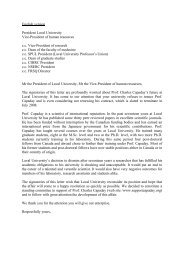Untitled - Laboratory of Neurophysics and Physiology
Untitled - Laboratory of Neurophysics and Physiology
Untitled - Laboratory of Neurophysics and Physiology
You also want an ePaper? Increase the reach of your titles
YUMPU automatically turns print PDFs into web optimized ePapers that Google loves.
to length- <strong>and</strong> γ-drive-dependent transfer functions <strong>of</strong> group Ia <strong>and</strong> group II muscle spindles. These<br />
transfer functions were calibrated (Fig. 1A) with extant data from passive movements in the cat [4].<br />
Results<br />
Our simulations suggest that (i) empirically observed muscle spindle activity pr<strong>of</strong>iles can to a large<br />
part be explained by a strongly task-dependent γ-drive (Fig. 1B), (ii) observed differences between<br />
individual muscle spindle response pr<strong>of</strong>iles can be explained by a corresponding variability in the γ-drive<br />
(Fig. 1B), <strong>and</strong> (iii) observed phase advance <strong>of</strong> spindle responses can to a large part be explained by<br />
appropriate γ-drive.<br />
Figure 1. A. Fit between passive [4] (dotted<br />
lines) <strong>and</strong> simulated (lines) Ia responses during<br />
sinusoidal stretch under constant γ D -drive<br />
(125 Hz) <strong>and</strong> 4 different rates <strong>of</strong> γ S -drive (top<br />
to bottom: 125, 75, 50, 0 Hz). B. Simulated<br />
Ia responses (left column) during active muscle<br />
contraction for 4 different γ S -drives (right column):<br />
no, phasic, tonic <strong>and</strong> phasic-tonic drive.<br />
The asterisk indicates simulated responses similar<br />
to empirically observed Ia responses [5].<br />
Conclusion<br />
Our simulation predicts that γ-drive is strongly modulated <strong>and</strong> task-dependent <strong>and</strong> that appropriate<br />
γ-drive can explain many empirically observed aspects <strong>of</strong> group Ia <strong>and</strong> II muscle spindle responses<br />
during active movements.<br />
References<br />
1. Prochazka A: Proprioceptive feedback <strong>and</strong> movement regulation. In: H<strong>and</strong>book <strong>of</strong> <strong>Physiology</strong>. Exercise:<br />
Regulation <strong>and</strong> Integration <strong>of</strong> Multiple Systems. Bethesda, MD: Am Physiol Soc, sect. 12, part I, p. 89-127.<br />
2. Windhorst U: Muscle spindles are multi-functional (Technical comment). Brain Res Bull 2008, 75:507-<br />
508.<br />
3. Maltenfort MG, Burke RE: Spindle model responsive to mixed fusimotor inputs <strong>and</strong> testable predictions<br />
<strong>of</strong> beta feedback effects. J Neurophysiol 2003, 89(5):2797-2809.<br />
4. Hulliger M, Matthews PBC, Noth J: Static <strong>and</strong> dynamic fusimotor action on the response <strong>of</strong> Ia<br />
fibres to low frequency sinusoidal stretching <strong>of</strong> widely ranging amplitudes. J Physiol (Lond) 1977,<br />
267:811-836.<br />
5. Flament D, Fortier PA, Fetz EE: Response patterns <strong>and</strong> post-spike effects <strong>of</strong> peripheral afferents in<br />
dorsal root ganglia <strong>of</strong> behaving monkeys. J Neurophysiol 1992, 67:875-889.<br />
O17<br />
Operant conditioning <strong>of</strong> single units in rat motor cortex allows graded control <strong>of</strong><br />
a prosthetic device<br />
Valerie Ego-Stengel ⋆ , Pierre-Jean Arduin, Yves Fregnac, <strong>and</strong> Daniel Shulz<br />
Unité de Neuroscience, Information et Complexité, UNIC-CNRS, Gif-sur-Yvette, 91190, France<br />
Operant control <strong>of</strong> a prosthesis by neuronal cortical activity is one <strong>of</strong> the successful strategies for<br />
implementing brain-machine interfaces, by which the subject learns to exert a volitional control <strong>of</strong><br />
72



